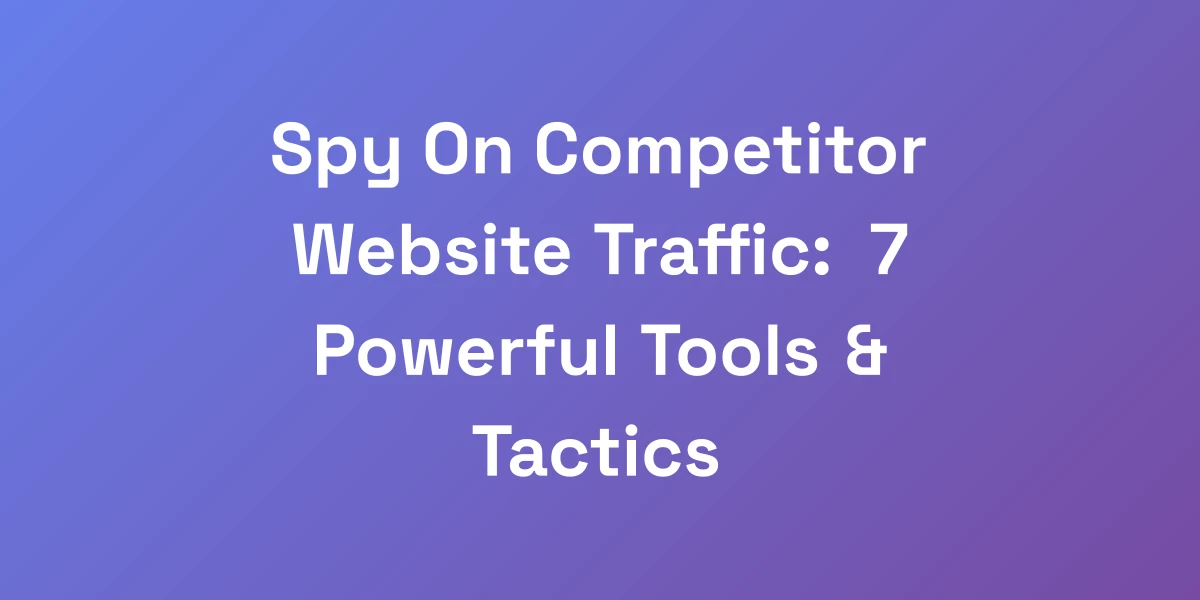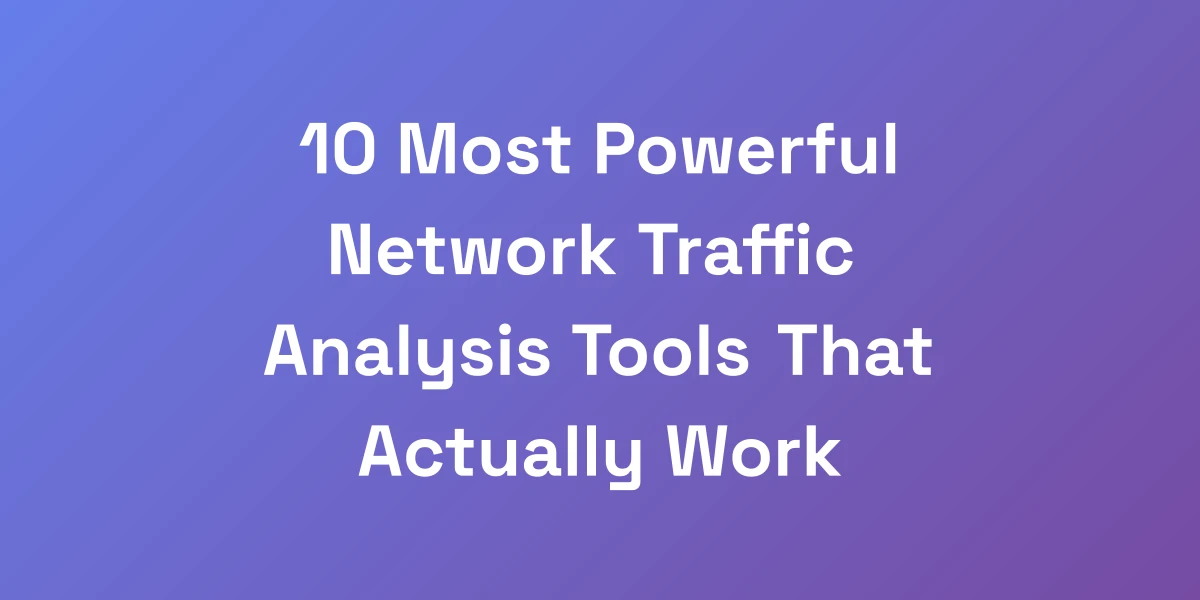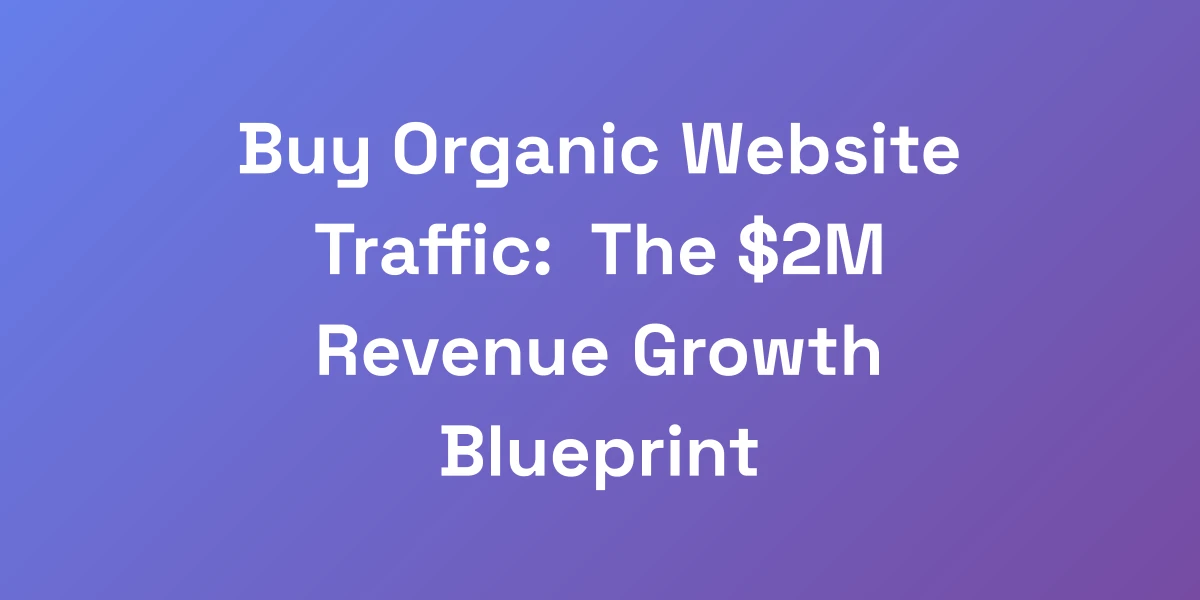
Spy On Competitor Website Traffic: 7 Powerful Tools & Tactics
Apr 9, 2025 | By [email protected]
Ever wondered how the top dogs seem to effortlessly dominate their niches? It’s not magic—it’s a meticulous strategy, and at the heart of it lies one crucial element: competitor website traffic analysis. Imagine having the ability to peek into your competitors’ websites and see exactly how much traffic they’re generating, where it’s coming from, and what’s driving their success. Sounds powerful, right? Well, it is. But here’s the kicker—most people are either unaware of this game-changing tactic or are using it incorrectly.
We’ve seen businesses skyrocket by leveraging the right tools and tactics to monitor competitor traffic. But without the right approach, all that data is just noise. Let’s cut through the fluff and get to the meat of how you can spy on competitor website traffic like a pro. We’re talking about actionable insights that you can implement today to outpace your rivals and drive your business forward.
Ready to turn the tables and gain that competitive edge? Let’s dive in and explore the seven powerful tools and tactics that will transform the way you view and utilize competitor traffic data.
Why Tracking Competitor Website Traffic Is Your Secret Weapon
Let me tell you something that changed our entire business game: knowing your competitors’ traffic numbers is like having X-ray vision into their entire business model. We’ve built multiple 8-figure businesses by reverse-engineering what works for others. But here’s the truth—most people are doing it wrong. They’re obsessed with vanity metrics when they should be focusing on actionable intelligence that drives revenue.
In this guide, we’re going to show you exactly how to analyze competitor website traffic in a way that actually moves the needle.
The Real ROI of Competitor Traffic Analysis
Why should you invest time and resources into tracking competitor traffic? Simple.
- Identify Market Trends: By analyzing where your competitors are getting their traffic, you can spot emerging trends before they hit mainstream. This aligns with the top trends and predictions for the future of marketing.
- Benchmarking: Understand how you stack up against the best in your industry by comparing key metrics.
- Strategic Planning: Use the insights to refine your marketing strategies, optimize your content, and target the right audience.
Think about it—if a competitor is seeing a surge in traffic from a specific channel, it’s a clear indicator that something is working. The real ROI here isn’t just the traffic numbers; it’s about the strategic advantage you gain by acting on that data. Learn more about proving competitive intelligence ROI to understand the full impact.
Common Mistakes in Traffic Analysis (And How to Avoid Them)
We’ve seen many businesses stumble because they focus on the wrong aspects of traffic analysis.
- Focusing on Vanity Metrics: Metrics like total visits or page views might look impressive but offer little actionable insight.
- Ignoring Traffic Sources: Not understanding where the traffic is coming from can lead to misinformed strategies.
- Lack of Context: Data without context is meaningless. You need to understand the story behind the numbers.
To avoid these pitfalls, always align your traffic analysis with your business goals. Focus on metrics that drive actions and decisions, not just numbers that look good on paper.
Setting Up Your Competitive Intelligence Framework
Before diving into tools and tactics, you need a solid framework. Here’s how we set it up:
- Define Your Goals: What do you want to achieve? Whether it’s increasing traffic, boosting conversions, or enhancing brand awareness, clarity is key.
- Identify Key Competitors: Not just the obvious ones, but also emerging players that could disrupt the market.
- Choose the Right Tools: Select tools that align with your goals and provide the necessary insights, such as the 15 Best SEO Tools for Agencies in 2025 and the top competitive intelligence software tools for 2024.
- Establish Metrics: Determine which metrics are most relevant to your goals, such as traffic sources, engagement rates, or conversion metrics.
- Implement Tracking: Set up regular monitoring to keep your data up-to-date and actionable. Consider incorporating marketing automation for agencies to streamline this process.
Having a structured framework ensures that your traffic analysis is not random but a strategic part of your business operations.
Key Metrics That Actually Matter
Not all metrics are created equal. Here are the ones that truly matter:
- Traffic Sources: Direct, Organic, Referral, Social, and Paid. Knowing where the traffic comes from helps you allocate resources effectively. Utilize Google Analytics statistics to gain deeper insights.
- Bounce Rate: High bounce rates can indicate issues with user experience or content relevance.
- Session Duration: Longer sessions usually mean more engaged visitors.
- Conversion Rate: Ultimately, conversions are what drive business growth.
- Geographical Distribution: Understanding where your visitors come from can tailor your marketing strategies.
Focusing on these key metrics provides a clear picture of what’s working and what needs improvement.
The 80/20 Rule of Traffic Analysis
We’ve all heard of the 80/20 rule—80% of your results come from 20% of your efforts. The same applies to traffic analysis. Focus on the top 20% of metrics that drive 80% of your results.
- Identify High-Impact Metrics: Concentrate on the metrics that directly influence your business goals.
- Prioritize Actionable Insights: Not all data is actionable. Focus on insights that can lead to tangible improvements.
By applying this principle, you ensure that your analysis is efficient and impactful, maximizing your return on effort.
The Ultimate Stack of Traffic Analysis Tools in 2025
Listen, we’ve spent hundreds of thousands of dollars testing every traffic analysis tool on the market. Most of them are garbage. But there are exactly seven tools that deliver consistent, reliable data you can actually use to make money. I’m not talking about cute graphs and charts—I’m talking about tools that give you the precise insights needed to outmaneuver your competition. Here’s what actually works, ranked by ROI potential. Check out the top web traffic analysis tools for 2025 to see the full list.
1. SimilarWeb: The Gold Standard (Pros & Cons)
SimilarWeb stands tall as the gold standard in traffic analysis. Here’s why:
- Pros:
- Comprehensive traffic sources analysis
- In-depth competitive benchmarking
- Global reach with detailed geographic insights
- Cons:
- Pricing starts at $199/month, which can be steep for smaller businesses
- Some data discrepancies due to estimation methods
Despite the cost, the value it provides in understanding competitor traffic is unmatched. SimilarWeb’s 2024 data update has further enhanced its accuracy, making it a staple for serious market analysts.
2. Ahrefs Traffic Analysis Features
Ahrefs isn’t just about backlinks; its traffic analysis features are top-notch. Here’s the breakdown:
- Pros:
- Extensive keyword tracking
- Backlink analysis integrated with traffic insights
- User-friendly interface with actionable data
- Cons:
- Can be overwhelming for beginners
- Pricing starts at $99/month, which might be restrictive for some
Ahrefs shines when you need to dig deep into SEO strategies. By analyzing competitor keywords and backlinks, you can identify traffic-driving elements that you might have overlooked using platforms like Backlinko’s competitor analysis tools.
3. SEMrush’s Traffic Analytics Suite
SEMrush offers a robust suite of tools that cover all aspects of traffic analysis:
- Pros:
- Comprehensive traffic sources and segmentation
- Detailed competitor analysis with traffic trends
- Integration with other SEMrush tools for holistic insights
- Cons:
- Plans start at $139.95/month, which is pricey
- Steeper learning curve due to extensive features
SEMrush’s Traffic Analytics Suite is invaluable for businesses looking to understand broader market dynamics and competitor strategies. It’s a favorite among SEO professionals for its depth and reliability.
4. Free vs Paid Tools: What’s Worth Your Money
While free tools offer basic insights, paid tools provide depth and accuracy that can make a real difference:
- Free Tools:
- Limited data and features
- Good for small businesses or initial research
- Paid Tools:
- Comprehensive data and advanced features
- Better accuracy and reliability
- Support and regular updates
Investing in paid tools like SimilarWeb, Ahrefs, or SEMrush is typically worth the cost for businesses serious about gaining actionable insights and staying ahead of the competition.
5. How to Combine Multiple Tools for Maximum Accuracy
No single tool is perfect. Combining multiple tools can provide a more comprehensive and accurate picture:
- Complementary Insights: Use SimilarWeb for overall traffic trends and Ahrefs for SEO-specific insights.
- Cross-Verification: Validate data points by comparing results from different tools.
- Diverse Perspectives: Each tool has its strengths, and using them together can cover all bases.
By leveraging multiple tools, you can ensure that your data is robust and reliable, reducing the risk of making decisions based on inaccurate information.
6. Advanced Features You’re Not Using (But Should Be)
Most users stick to basic features, but the advanced functionalities can provide deeper insights:
- Predictive Traffic Modeling: Forecast future traffic trends based on historical data.
- Market Share Calculation: Understand your position within the market relative to competitors.
- Cross-Channel Attribution: Track how different marketing channels contribute to traffic and conversions.
Utilizing these advanced features can uncover hidden opportunities and fine-tune your strategies for maximum impact. Explore resources like how to measure the ROI of intelligence to maximize these capabilities.
7. Matomo: Privacy-Focused Analytics
For those who prioritize data privacy, Matomo is a stellar choice:
- Pros:
- Self-hosted option for full data ownership
- GDPR compliant, ensuring data privacy
- Detailed traffic reports with no data sampling
- Cons:
- Requires technical expertise for self-hosting
- Limited integrations compared to other tools
Matomo is ideal for businesses that need to maintain strict control over their data while still gaining valuable traffic insights.
Extracting Actionable Intelligence From Traffic Data
Raw data is worthless without proper interpretation. After analyzing over 1,000 competitors across various industries, we’ve developed a framework that turns traffic data into revenue opportunities. The key isn’t just knowing their numbers—it’s understanding the patterns and anomalies that signal market opportunities. Here’s how to turn competitor traffic data into your competitive advantage.
Traffic Source Analysis Framework
Understanding where your competitors’ traffic is coming from is the first step:
- Direct Traffic: Assess brand strength and customer loyalty.
- Organic Search: Identify effective SEO strategies and high-performing keywords.
- Referral Traffic: Discover valuable partnerships and backlink sources.
- Social Media: Gauge the effectiveness of their social media strategies.
- Paid Search: Analyze their PPC campaigns and budget allocation.
By dissecting each traffic source, you can replicate the successful strategies and identify gaps in your own approach.
Content Performance Patterns
Content is king, but not all content is created equal. To harness the power of your competitor’s content:
- Top-Performing Pages: Identify which pages are driving the most traffic and understand why they resonate with the audience.
- Content Types: Determine which formats (blogs, videos, infographics) are performing best and consider incorporating similar types into your strategy.
- Engagement Metrics: Look at metrics like average time on page and bounce rate to gauge content effectiveness.
Replicating successful content strategies can significantly boost your own traffic and engagement metrics. Refer to inspirational data quotes to motivate your team in adopting data-driven content strategies.
Seasonal Trends and Market Timing
Tapping into seasonal trends can provide a competitive edge. Here’s how:
- Identify Peak Times: Determine when your competitors experience traffic spikes and plan your campaigns accordingly.
- Content Calendar: Align your content creation with seasonal interests and trends to maximize relevancy and engagement.
- Promotional Strategies: Launch promotions during peak traffic times to coincide with increased user interest.
Understanding seasonal patterns allows you to time your marketing efforts for maximum impact, ensuring you capitalize on high traffic periods.
Geographic Distribution Insights
Knowing where your competitors’ traffic is coming from geographically can inform your expansion strategies:
- Top Regions: Identify regions where competitors are strong and determine if there’s potential for your own growth.
- Localized Marketing: Tailor your marketing strategies to cater to the preferences and behaviors of specific regions.
- Market Penetration: Analyze geographic traffic distribution to discover underserved markets.
Targeting the right geographical areas can enhance your market penetration and drive localized growth.
Device & Platform Analysis
With the mobile traffic surge, understanding device usage is crucial:
- Mobile vs. Desktop: Analyze the proportion of traffic from mobile devices and optimize your website for mobile if necessary. Explore mobile vs desktop usage trends.
- Platform Preferences: Determine which platforms (iOS, Android, Windows) are more popular among your competitor’s audience.
- User Experience: Assess how well your competitors’ sites perform on different devices and strive to offer a superior experience.
Optimizing for the dominant devices in your market ensures you’re providing the best possible user experience, driving higher engagement and conversions. Stay updated with the latest mobile vs desktop usage in 2024 trends to keep your strategies relevant.
Engagement Metrics That Predict Success
Engagement metrics are the heartbeat of traffic analysis:
- Average Session Duration: Longer sessions indicate higher engagement, suggesting that your competitors’ content is resonating well.
- Pages Per Session: More pages per session can signify better content quality and user interest.
- Conversion Rates: Understanding what drives conversions on competitor sites can help you optimize your own.
By focusing on these engagement metrics, you can gauge the effectiveness of your competitors’ strategies and refine your own to achieve better results. Refer to average engagement rate benchmarks to measure your performance.
Advanced Traffic Analysis Strategies Most People Miss
Here’s what separates the amateurs from the pros: the ability to see beyond basic metrics. While your competitors are focusing on homepage traffic, you’ll be diving deep into the micro-patterns that reveal true market opportunities. We’ve used these exact strategies to identify gaps worth millions in revenue. The best part? Almost nobody is doing this right.
Micro-Conversion Analysis
Most analyses stop at major conversions, but micro-conversions can provide invaluable insights:
- Track User Actions: Monitor actions like newsletter sign-ups, downloads, or video views to understand user engagement phases.
- Identify Drop-Off Points: Discover where users lose interest and optimize those stages to improve overall conversion rates.
- Enhance User Journey: Use micro-conversion data to refine the user journey and guide visitors towards major conversions.
Micro-conversions offer a granular view of user behavior, allowing you to make precise adjustments that enhance overall engagement and conversions.
Cross-Channel Attribution Patterns
Understanding how different marketing channels contribute to traffic and conversions is essential:
- Multi-Touch Attribution: Analyze how multiple channels work together to drive traffic and conversions.
- Channel Performance: Identify which channels are most effective in driving high-quality traffic and focus your efforts there.
- Resource Allocation: Allocate your marketing budget based on the performance of each channel to maximize ROI.
Cross-channel attribution provides a holistic view of your marketing efforts, enabling you to optimize your strategies across all platforms.
Content Gap Analysis Through Traffic Data
Content gap analysis helps you identify what’s missing in your current strategy:
- Identify Uncovered Topics: Discover topics that your competitors are covering but you’re not, and capitalize on them.
- Enhance Existing Content: Improve your content by addressing gaps in information or user intent that your competitors are fulfilling.
- Expand Content Strategy: Broaden your content offerings to include areas where there’s demand but limited supply.
Filling content gaps can attract more traffic and position you as a more comprehensive resource in your industry.
Competitor Funnel Mapping
Mapping out your competitors’ sales funnels reveals how they convert traffic into customers:
- Identify Funnel Stages: Understand the different stages your competitors use to guide users from awareness to conversion.
- Optimize Your Funnel: Implement similar funnel stages while optimizing each step for better performance.
- Benchmark Funnel Metrics: Compare your funnel performance against competitors to identify areas for improvement.
Competitor funnel mapping allows you to refine your own funnel, improving conversion rates and overall effectiveness.
Market Share Calculation Methods
Understanding your market share compared to competitors indicates your position in the industry:
- Traffic-Based Market Share: Calculate your share based on your traffic relative to the total industry traffic.
- Revenue-Based Market Share: If accessible, compare your revenue against industry leaders to gauge your market standing.
- Targeted Metrics: Use specific metrics relevant to your niche for a more accurate market share analysis.
By knowing your market share, you can set realistic growth targets and identify strategies to increase your presence. Refer to the competitive intelligence tools strategic business report for detailed insights.
Predictive Traffic Modeling
Predictive traffic modeling uses historical data to forecast future traffic trends:
- Trend Analysis: Identify patterns in your competitors’ traffic data to predict future movements.
- Scenario Planning: Use predictive models to simulate different scenarios and plan your strategies accordingly.
- Proactive Adjustments: Adjust your marketing efforts in anticipation of future trends, staying ahead of the competition.
Predictive traffic modeling enables you to make informed decisions that prepare your business for future market conditions.
Conclusion
Tracking competitor website traffic is more than just a strategy—it’s a necessity in today’s fiercely competitive market. By leveraging the right tools and tactics, you can turn raw data into actionable insights that drive your business forward. From understanding traffic sources and content performance to utilizing advanced strategies like predictive modeling and AI-driven insights, the opportunities are endless.
We’ve walked you through the essential tools—SimilarWeb, Ahrefs, SEMrush, and more—and explored how to extract and apply meaningful intelligence from traffic data. Now, it’s your turn to implement these strategies and watch your business grow.
Start today by selecting the tools that best fit your needs, setting up a robust framework, and diving deep into your competitors’ traffic data. The competitive edge you gain from this analysis could be the difference between stagnation and exponential growth.
Ready to take your traffic analysis to the next level? Don’t wait—start spying on your competitors’ website traffic now and unlock the secrets to their success. Have thoughts or questions about traffic analysis? Share them below and let’s continue the conversation about SEO freelancing! Check out this YouTube video on traffic analysis for more insights.








